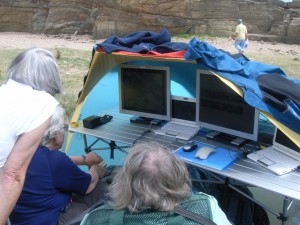 Tutor and students at the ERA base location viewing the video feed and communicating via VoIP with the field geologist. Howick, Friday 07 August 2009
Tutor and students at the ERA base location viewing the video feed and communicating via VoIP with the field geologist. Howick, Friday 07 August 2009
The curse of ERA – bringing sunny weather to field trips – strikes again! Despite packing gaiters, gortex, and waterproof sample bags to protect our kit, it was the sunshine rather than the rain that was the challenging weather for the Durham area field trips.
Jokes aside, we’ve had great weather, mainly sunny with the occasional light smattering of rain. This is actually a significant factor for us when we’re working in the field. The radio signal isn’t affected by rain to any great degree, we’re fairly confident that students will dive for cover before the radio signal deteriorates too far in rainy conditions, but we have to watch out for sun and rain when it comes to using the equipment in the field.
We’re aiming to use off-the-shelf, consumer equipment as much as possible so as to come up with a solution that could be taken up by the greatest number of other educational institutions. There is heavily ruggedised military-specification equipment for most of what we’re doing but the cost and weight factors puts this out of our league and probably would make the ERA system much less likely to be adopted by a broad community of users.
So we have to be a little careful when working outside. We’ve noticed the Asus Eee PC trackpads aren’t too fond of rain and so geologists’ sample bags make useful sleeves to keep the keyboards and trackpads dry. USB mice seem to be more popular than the built in trackpads regardless of the weather.
However, as I’ve hinted, like with previous ERA trials, our major challenge is the sun, not something we necessarily expected in the great British summer. Bright sunny days mean that screen visibility is lowered. This is an issue for the geology students who are keen to view as much detail as possible and be able to differentiate quite subtle colour and textural differences in the materials they are studying. Certainly providing 17″ LCD monitors for students helps, the size and brightness of these screens seem to be much preferred over the built in 9″ Asus Eee PC screens (we’re now using the Asus 901’s rather than last year’s smaller 701’s). The large screens draw more battery power, but we’re getting over 2 hours out of our new high tech batteries. We’ve explored using a video splitter to give us two identical outputs on screens pointing in different directions to allow more students to see, but we found that the geology staff and students liked two screens set up with the video and audio feed coming through one, and the high resolution picture gallery set up on a second.
To help with visibility, we’ve been experimenting with using an open-sided ‘beach tent’ that allows us to slide in two camping tables and the monitors, providing a degree of sun shade. This definitely helps but some further improvements still required. Prof. Bob Spicer has suggested we find out about ‘polar tents’ which are designed to cut out as much light as possible, so another trip to the outdoors shops beckons. John notes that OLED displays will be arriving in the marketplace soon and these are likely to make quite a difference.

Pingback: Portable VoWLAN: A portable voice over wireless local area network for mobile learning « VoWLAN